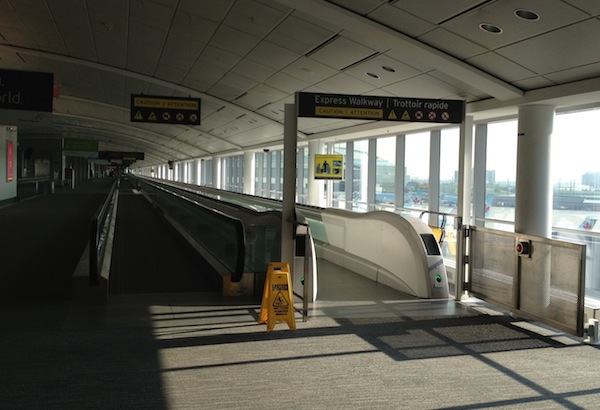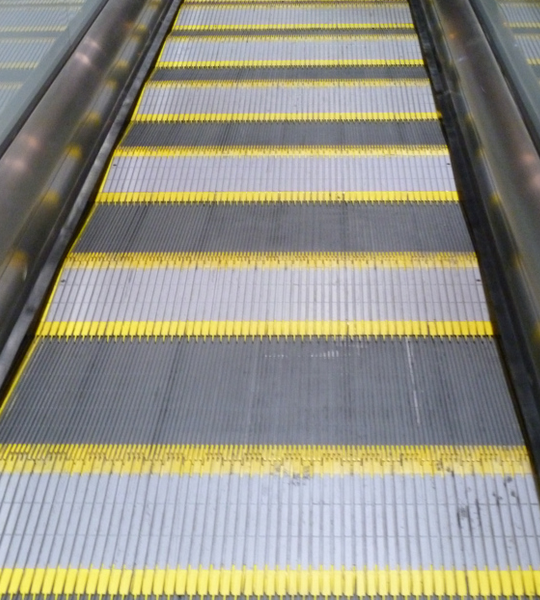I love that name! “Travelator” is what the British call a moving walkway, which is ironic since it’s a portmanteau of “travel” and “escalator.” “elevator” yet British people prefer the word “lift.” British people also like onion and butter sandwiches (served in economy class on one of my British Airways flights) so I’ve stopped trying to figure them out. Clearly I was either dense when I wrote this or I have an alternate personality so determined to make a joke about the British that I overlooked the similarity between a moving walkway and an escalator.
Regardless, travelators are cool because whenever you’re stuck in an airport with long, long walkways, they offer a small amount of escape assuming you have the time to relax and let yourself be carried. They also lead to some cool opportuntiies for changing levels, such as the Habitrail-like maze at Charles DeGaulle.

I like them because if you get a good running start, there’s this great jerking sensation when you run off the end of the walkway (try it in Denver). And it can be fun to walk in the wrong direction and find yourself going nowhere fast. Math classes should take field trips to explore the differences between speed, velocity, and acceleration in real-life scenarios.
The only “express” travelator in the world is at Toronto Pearson International Airport and is probably my favorite thing about that airport. After arriving on an international flight, there can be a very long walk to border control. You will have the option between a series of standard travelators that move at about 3 km/h or one very long travelator that moves at about 5 km/h. The choice is obvious.
Instead of a series of flat platforms that follow one after another, the express travelator uses angled platforms that can slide underneath each other. Speed is a function of distance over time. By stacking near either end, the platforms become shorter and the travelator moves slower to make entering and existing easier. In the middle, these platforms slide out and lengthen, so you speed up.
I took my own video, but since it and all the others online are shaky, I see no point going through the hassle and have shared someone else’s. The number of individual platforms that move past a given point over time never changes along the path. If one panel must pass a point every second, and if the panel becomes twice as long, then it must move twice as fast.

They need something like this at Sea-Tac’s Concourse A. And lots of other places. (I think I walked almost a mile to get to the Senator Lounge during our stop at Frankfurt during Star MegaDO 4.)
There was once another express travelator in Paris, part of the RATP Montparnasse-Bienvenue station, which has a 110 meter tunnel connecting separate platforms. They called it “le troittoir roulant rapide” (fast rolling pavement). You can’t beat the French at coming up with impressive-sounding names for stuff.
I’ve never actually been to this station despite visiting Paris while the TRR was in operation from 2002 through 2009. It reached speeds of up to 9 km/h (almost double Toronto’s travelator) and had to be reduced at one point because of too many accidents when people unfamiliar with the system would fall and hurt themselves. Eventually it was replaced with more traditional technology.
I’m not surprised. Although it sounds incredibly fun, some people are intimidated by automated transit. My grandmother, even when she had trouble walking in her 90s, was terrified of escalators and would use the stairs. She was afraid she would put one foot on and it would carry her away before she could get the second. The Montparnasse system used a series of rollers to accelerate the rider. You pretty much had to keep your feet planted and hold onto the handrail to keep yourself upright — something always recommended but rarely followed on slower systems.
Until more places adopt express travelators, I’ll have to get my kicks in Toronto. I’m not sure it’s enough to encourage me to connect there. It does, at least, make the pain of connecting on the East Coast on my way to Europe somewhat more bearable.

